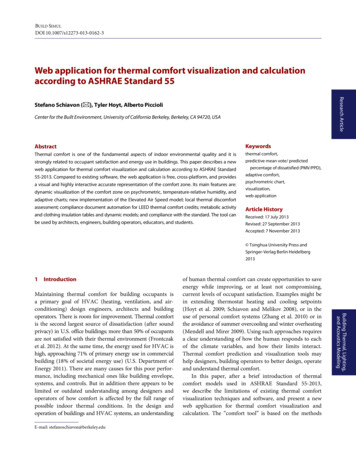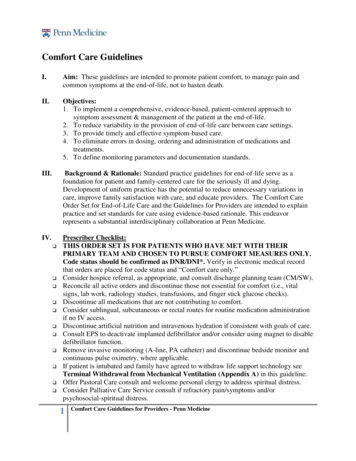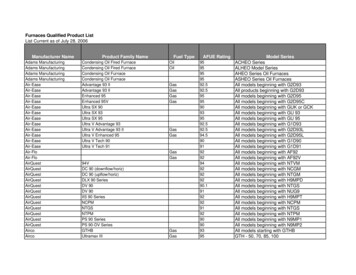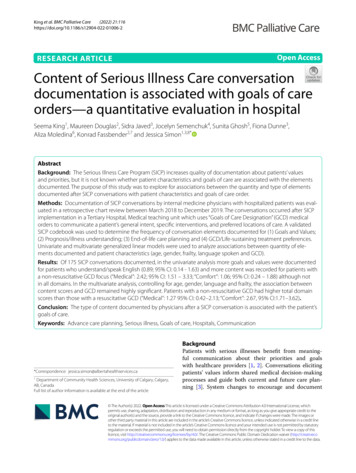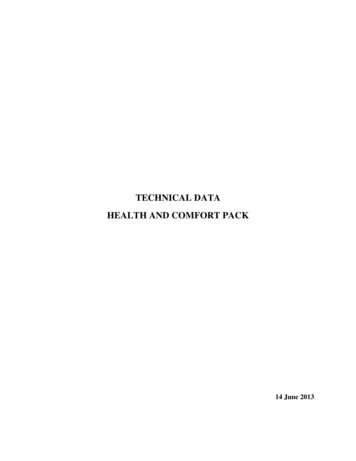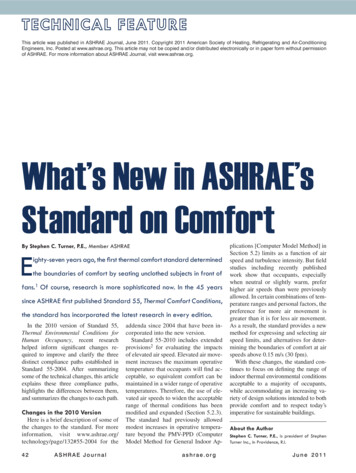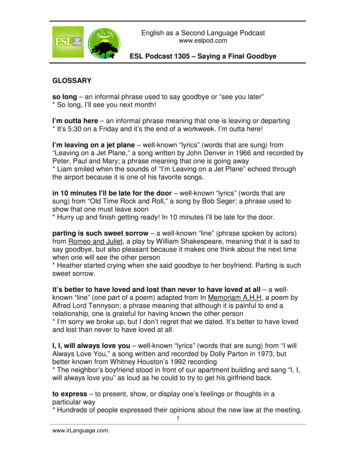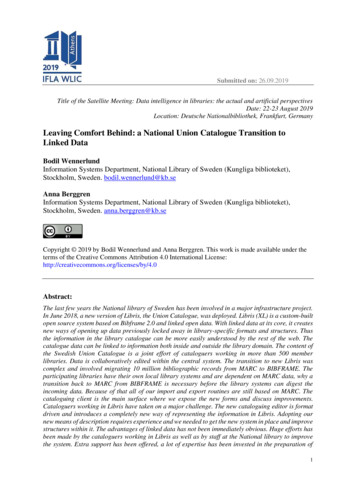
Transcription
Submitted on: 26.09.2019Title of the Satellite Meeting: Data intelligence in libraries: the actual and artificial perspectivesDate: 22-23 August 2019Location: Deutsche Nationalbibliothek, Frankfurt, GermanyLeaving Comfort Behind: a National Union Catalogue Transition toLinked DataBodil WennerlundInformation Systems Department, National Library of Sweden (Kungliga biblioteket),Stockholm, Sweden. bodil.wennerlund@kb.seAnna BerggrenInformation Systems Department, National Library of Sweden (Kungliga biblioteket),Stockholm, Sweden. anna.berggren@kb.seCopyright 2019 by Bodil Wennerlund and Anna Berggren. This work is made available under theterms of the Creative Commons Attribution 4.0 International Abstract:The last few years the National library of Sweden has been involved in a major infrastructure project.In June 2018, a new version of Libris, the Union Catalogue, was deployed. Libris (XL) is a custom-builtopen source system based on Bibframe 2.0 and linked open data. With linked data at its core, it createsnew ways of opening up data previously locked away in library-specific formats and structures. Thusthe information in the library catalogue can be more easily understood by the rest of the web. Thecatalogue data can be linked to information both inside and outside the library domain. The content ofthe Swedish Union Catalogue is a joint effort of cataloguers working in more than 500 memberlibraries. Data is collaboratively edited within the central system. The transition to new Libris wascomplex and involved migrating 10 million bibliographic records from MARC to BIBFRAME. Theparticipating libraries have their own local library systems and are dependent on MARC data, why atransition back to MARC from BIBFRAME is necessary before the library systems can digest theincoming data. Because of that all of our import and export routines are still based on MARC. Thecataloguing client is the main surface where we expose the new forms and discuss improvements.Cataloguers working in Libris have taken on a major challenge. The new cataloguing editor is formatdriven and introduces a completely new way of representing the information in Libris. Adopting ournew means of description requires experience and we needed to get the new system in place and improvestructures within it. The advantages of linked data has not been immediately obvious. Huge efforts hasbeen made by the cataloguers working in Libris as well as by staff at the National library to improvethe system. Extra support has been offered, a lot of expertise has been invested in the preparation of1
technical documentation, help texts, instruction movies, experts has participated in developing newfeatures and loads of user feedback has been given to the development team.Keywords: National union catalogue, Sweden, BIBFRAME, Linked data, Software developmentIn June 2018, the National Library of Sweden (KB) launched a new generation of LIBRIS,the Swedish union catalogue. The new LIBRIS, named XL,1 is a custom-built open sourcesystem based on BIBFRAME 2.0 and linked open data. The system is developed at KB by ateam of developers, designers and specialists on data modelling and metadata. With linkeddata at its core, Libris XL creates new ways of opening up data previously locked away inlibrary-specific formats and structures. The information in the library catalogue can be moreeasily understood by the rest of the web, and link to information both inside and outside thelibrary domain.This paper focuses mainly on the transition to LIBRIS XL, particularly on the launch andimplementation from 2017 to date.1.1 Libris – the union catalogue of SwedenInitiated in the 1970s, Libris is the joint effort of more than 500 Swedish university andspecial libraries, the National library and, from 2011, public libraries. Data is collaborativelyedited within the central system and then exported to local library systems. This way, apublication is catalogued only once and then made available to all Libris libraries, who onlyneed to register their holdings. The National Library (KB below) is responsible for thedevelopment, maintenance and support of Libris. Libris currently stores around 11 millionresources, including the Swedish national bibliography and authority file. Also, the memberlibraries have added ca 35 million holdings related to the titles. It is worth noting that primarycataloguing is not the most common cataloguing work flow as most records are created inLibris via imports from book vendors and other partners. Cataloguers enrich basic recordsalready stored in Libris, alternatively download records from other sources such as the BritishNational Bibliography and modify them. Also, the number of e-resources has increasedsubstantially in recent years in relation to books and other physical resources. For example,around 100,000 bibliographic records describing e-resources are imported each week.Libris also offers a public OPAC2 and an inter-library lending system.Over its 47 year lifespan Libris has run on different platforms – 2002 to 2018 on Voyager from Ex Libris. The internal format of Voyager was MARC21 which triggered aconversion of the Libris data from legacy format LIBRISMARC to MARC21 in connectionwith the migration. Librarians used the Voyager desktop cataloguing tool to edit Libris,with an interface largely in MARC21. Many Libris cataloguers are very experienced with1LIBRIS was first launched in 1972 and celebrated its 40th (XL) anniversary in 2012 when prestudyactivities around the new system were in progress.2The Libris OPAC http://libris.kb.se/ is the public search interface of Libris, including information onwhich libraries hold the title. The OPAC is populated with data from LIBRIS XL. Its user interface has not beenredesigned within the LIBRIS XL project.2
MARC21 and know exactly how a Libris record will land in their local system.This was all about to be challenged by LIBRIS XL.1.2 Libris at a crossroadsAround 2008, KB began to seriously consider the future of Libris. Ideas related to linkeddata, Web 2.0 and the semantic web began to develop in the wider world. The Libris contenthad become increasingly diverse and the MARC model was not suitable for describing newtypes of data, e.g. e-resources. The existing platform based on MARC21 was difficult todevelop and maintain, and proposals for new services around Libris were put on hold.Historic layers also meant that old and new records had different structures. Performanceissues were becoming problematic due to the architecture of the system. In effect, the Librisdata was locked into a system past its prime.Meanwhile, the MARC format was being questioned within the library community. In its2008 report On the record the Library of Congress stated that MARC is "based on forty-yearold techniques for data management and is out of step with programming styles of today."As a consequence, KBs architects and developers began experimentally exploring ideas for anew system. A few high-level objectives were defined early on: A new, structured data model to efficiently describe new and diverse materials, e.g.electronic publications, music, or films. The new system should be built on linked data Linked data will open up library material to users, applications etc. inside andoutside the library community. Linked data can be used to incorporate data from other systems and contextsinto LIBRIS. The new system must be able to handle the rapidly growing data volumes. The new system must be an open system –via open APIs3 and publicly available code(open source).To realise LIBRIS XL as a Linked data system, KB turned its attention to the BIBFRAMEinitiative aiming at replacing MARC. In 2012, the Library of Congress released a draftversion and the design process of LIBRIS XL began. However, it was not until the 2016release of BIBFRAME version 2.0 that the architecture of the new system fell into place anda version of BIBFRAME 2.0 adapted to LIBRIS XL, with a Swedish vocabulary wasmodelled.KB now decided it was time to take action and launch an implementation project.The new system and project was named LIBRIS XL.3Application programming interfaces (API) offer other systems ways of communicating with Libris andusing its data.3
Architecture of LIBRIS1.3 The implementation projectA radical plan was conceived to abandon MARC21 in favour of Linked data withJSON-LD (RDF) as a storage format in the new LIBRIS XL core.4 However, since largeparts of the library community are likely to use MARC for years to come, KB still has aresponsibility for making data available to libraries in a form they can use. Also, many of thesurrounding library and discovery systems are complex with modules working on MARCdata. These modules may not be changed in the near future. In fact, at the moment no locallibrary system in production in Sweden receives linked data or records in JSON-LD fromLIBRIS XL.As a consequence, the new system must be able to import and export data in MARC21. TheLIBRIS XL project conceived a transformation mapping intended to provide local systemswith LIBRIS XL data similar to the old system. However, it was clear from the start that theMARC21 transformed from LIBRIS XL would not be identical to the old MARC21 records.For example: BIBFRAME does not use punctuation at the end of elements which means thatis impossible in some cases to add punctuations in the transformation.Lessons learned from the transformation mapping are Local library systems interpret the MARC21 data very differently which means thatthe project in some cases has had to implement library specific export transformationmapping from LIBRIS XL, and Mapping activities (analysis, development and testing) were more labour intensivethan estimated and required expert resources on metadata, local library systems andMARC21 and BIBFRAME.4JSON-LD (JavaScript Object Notation for Linked Data) is a method of encoding Linked Data. JSON-LDis mapped to RDF, the Resource Description Framework.4
The migration and transformation of MARC21 data to LIBRIS XL were a big part of theimplementation project. KBs metadata experts provided guidelines for the migration, one wasto leave certain metadata behind (but not discard it), and that quality enhancing activitiesshould be on improving functionality, not to make it look nicer.1.4 What about the cataloguers?A monograph Nordiska myter in LIBRIS XL. Links are indicated as pills.A new web-based cataloguing tool was designed by KB, with a model-driven (JSON-LD)interface providing a fairly unfiltered view of the LIBRIS data. As a consequence,bibliographic information, holdings and authorities are presented in a completely new way tothe LIBRIS cataloguers who are familiar with MARC21. The cataloguing interface is openand available for browsing at libris.kb.se/katalogisering, but only Libris users can edit in thetool. The cataloguing interface is not intended as a discovery or circulation tool and theexisting Libris OPAC is still live at libris.kb.se – populated with data synchronized fromLIBRIS XL.Cataloguers working in Libris have met with a major challenge. The new tool is a radicallydifferent experience from the previous MARC21 tool. Since it is format driven it introduces acompletely new way of representing the information in Libris. Adopting the new means ofdescription requires experience and KB needed to get the new system in place and improvestructures within it. The BIBFRAME data takes up more space than the previous, verycompact, MARC21 records. Cataloguing in LIBRIS XL requires linking to authorities,5
subject headings etc. This in its turn means scrolling and clicking on links, as opposed totyping.Linking to an authority in https://libris.kb.se/katalogisering1.5 The big leap - launching LIBRIS XLIn 2017, the project governing structure, consisting of KB’s internal steering group and theLibris development council, decided it was time to launch LIBRIS XL. A beta version of thecataloguing tool was made available for those who wanted a preview. However, a livelydiscussion within the LIBRIS network led to expressed concerns that the new system was notyet functional or robust enough to go live. Many stakeholders would also have preferred tokeep the old system in production parallel to LIBRIS XL, which would enable a morecautious shift, and more time to get used to the new format. However, parallel operation oftwo Libris systems was not considered realistic by KB due to, primarily, the massive task ofmaintaining data flows to and from two systems.A big concern was whether the new editing tool would be functional for librarians to keep uptheir processes and not fall behind cataloguing incoming resources. After evaluating the betaversion many libraries had serious doubts – the tool appeared to have inadequacies andlacked some functionalities. KB responded by defining the new tool as a start version andindicated that new features would be released very soon after the initial launch. For example:although the start version only had cataloguing templates for basic monographs, serials andholdings additional templates would be added in upcoming versions. The spring of 2018 wasspent adding important cataloguing features and refining XLs BIBFRAME format, mappingsand integration flows.Libris User Conference2017 "Let's go live withLIBRIS XL" (Dec 2017)Testing anddeveloping startversion (Jan-Apr)Releasecandidate forfinal evaluation (7May 2018)LIBRIS XL version1.0 live (11 June2018)Monthly releasesbeginning 13September 2018Timeline of LIBRIS XL launch6
After lengthy discussions on the stability of the system and the best, or least problematic,point in time for the system switch, it was decided that June 2018 would suit the libraries.The switch meant one week’s downtime where neither old nor new LIBRIS would be open(users could still search the OPAC though).A release candidate (the start version) was pushed to the Libris community for testing andevaluation in May 2018. Activities such as test sessions, workshops and product demos wereorganized by KB and the Libris libraries. Many libraries actively prepared for the big switch,setting up their own work groups to deal with potential issues caused by the new system.4 June 2018 all cataloguing in LIBRIS was suspended and the Voyager platform shut downfor edit. The LIBRIS XL team then began the migration and transformation of more than 10million records from MARC21 to BIBFRAME XL. Functionalities were deployed, includingthe new cataloguing tool and backend functionalities for imports and exports to the newsystem. LIBRIS XL was indexed for searching with the search engine Elasticsearch. The firstediting in the new cataloguing tool was made by KBs National Bibliography Unit on 8 June2018 to verify that the new system was operational. At the time of launch LIBRIS XL hadcataloguing templates, mapping and transformation to MARC21, including MARC21 viewsof the records, exports to local library systems as well as documentation and user help.When LIBRIS XL went live 11 June, the information in the catalogue was opened up to therest of the web and KB became the first national library in the world to switch to cataloguingin BIBFRAME.1.6 Communication and supportProfessional communication, support and user assistance proved a key success factor early onin the LIBRIS XL implementation. In 2017, KB assigned a team to deal with these issues aspart of the implementation. Activities included authoring help texts and guidelines forcataloguing in LIBRIS XL. Existing social media channels were used throughout to reach outand collaborate with libraries. The Libris blog was essential and used for weeklycommunications around LIBRIS XL, e.g. information on upcoming releases.5An extended support team was set up, meeting daily to manage and assign incoming issuesfor action. The Libris support site was used especially for questions, suggestions anddiscussions. Since the launch of LIBRIS XL more than 1,000 discussions have been initiatedon the Libris support site.6It was decided initially not to produce traditional manuals for LIBRIS XL. Guidelines, helpand user assistance would either be included in the new system, or published on social mediachannels. One example are YouTube instruction videos focussing on specific topics.71.7 Preparing for chaosAfter years of discussions on the future of LIBRIS, the member libraries, including KB,found themselves facing the big shift. The mood was apprehensive, a mix of anticipation andawe. Would LIBRIS XL really be launched as planned? Cataloguers feared the inevitable5The Libris blog is from June 2019 part of the new KB website tml New content is added regularly.6Supportforum för nya Libris https://kundo.se/org/librisxl/7YouTube playlist Instruktionsfilmer för Libris katalogisering https://youtu.be/9MzVriPQUA87
drop in productivity and potential problems with quality and MARC mappings from the newsystem. There were known remaining issues waiting to be solved in the data flows fromLIBRIS XL to local systems. However, many libraries had at this point decided to initiateactivities to facilitate the LIBRIS XL implementation and make it less stressful.The National bibliography cataloguing team at KB, although optimistic about the newsystem, decided to prepare for potential disaster by assigning a task force to test, evaluaterisks and adjust the cataloguing processes to the new situation. As a result, productivitytargets were temporarily dropped. By the launch of LIBRIS XL, they were ready for chaos.As anticipated, the team’s productivity during the summer of 2018 was indeed only a fractionof their normal average. The usual focus on cataloguing excellence was abandoned in favourof exploring and learning. In parallel, the cataloguers created help texts, guidelines andinstruction videos in cooperation with the LIBRIS XL development team and other experts.Problems and suggestions were coordinated and channelled in writing to the LIBRIS XLproject team. In the end disaster and chaos did not occur for this team of experiencedcataloguers and towards the end of 2018, they were back almost to normal productivity.The Libris member libraries have of course met different challenges depending on size,processes, local systems, subject focus etcetera. Some larger libraries, like KB, assignedspecial teams to ease the implementation of LIBRIS XL, for example by organizingworkshops and supporting learning and transfer of know-how. Some libraries needed to focuson further testing and evaluation of how data from the new system worked in their localsystems including mapping issues from Bibframe to MARC. Some libraries lacked templatesadapted to their type of resources and had to find workarounds, or decide whether to pausecataloguing of certain resources.The impact of LIBRIS XL from the perspective of reduced cataloguing throughput variedbetween libraries. It depends on a number of factors, for example the types of material thelibrary holds – the more diverse, the longer the period of low productivity.1.8 Post launch – developing while in productionAt the time of launch in June 2018, expectations on the KB development team to releaseadditional functionalities without delay was great. Many libraries felt they had been pressuredto accept the new system and now wanted guarantees that their most wanted features wouldbe released soon. KB received lists of requirements, especially from the large memberlibraries.In fact, KBs development team was already busy working on new features, templates and bugfixes. Beginning September 2018, new versions of LIBRIS XL have been released monthly.To make this possible, the team follows a strict agile (Scrum) process with biweekly sprintplanning and daily scrum meetings.8 Since all user input channelled via KB:s social media,customer support and e-mails is screened by the support team, only genuine candidates fordevelopment will be added to the project backlog. This has taken care of duplicate requestsand issues not related to the LIBRIS XL system, as well as allowed the development team tostay focused. Issues for potential development are analysed, documented and categorisedcontinuously based on feedback from team members, product owner and other stakeholders.The agile development process creates a method for incorporating new ideas and changing8Scrum is a widely used agile framework for software development.https://en.wikipedia.org/wiki/Scrum (software development)8
requirements as well as reconsidering prioritisations based on input from the memberlibraries.Analysis and development of new features has in many cases been done jointly by designers,developers and experts/librarians in the Libris network. For example, templates forcataloguing special materials such as sheet music, maps or computer games have beendeveloped and verified in close cooperation with experts from Swedish libraries, often inworkshops.A roadmap is available on html toindicate future development of LIBRIS XL on a high level.1.9 LIBRIS XL one year on – where are we now?The advantages of linked data have not been immediately obvious. Huge efforts have beenmade by cataloguers working in Libris as well as by staff at the National library to improve thesystem. Extra support has been offered to users, a lot of expertise has been invested in thepreparation of technical documentation, help texts and instruction videos. Experts haveparticipated in developing new features, and plenty of user feedback has been given to thesupport and development team.The transition to LIBRIS XL was complex and involved migrating over 10 millionbibliographic records from MARC. The participating libraries have their own local librarysystems and are dependent on MARC data, why a transition back to MARC fromBIBFRAME is necessary before library systems can digest the incoming data. Because ofthat all of our import and export routines are still based on MARC. The cataloguing tool isthe main interface to expose new structures and discuss improvements.Some of the lessons learned were quite unexpected: The new system forced re-evaluating the processes: Why did we do this? What’s theuse of this piece of data? As a consequence, some requirements in the LIBRIS XLbacklog are no longer valid, or could be implemented a different way.Developing the new system has inspired many interesting new collaborations in theLibris network. The potential to open up and expand collaborations around futuredevelopment is great.The effect of new systems on people: “It’s been tough, but very interesting how a newsystem has affected our organization.” One example is more equality between juniorand senior cataloguers.In the future, it is reasonable to assume that fewer cataloguers will need to do morework. It follows that manual work should be limited to the intellectual parts ofcataloguing and that more automation needs to be implemented. What can beeliminated?Future activities include modelling of LIBRIS XL so that the Works level of BIBFRAME canbe introduced, bringing benefits such as improved data quality, search and linkingopportunities. Ideas for opening up the library data to the rest of the world are emerging andlibraries are considering their own processes.At this time there is definitely a feeling that Libris belongs to the libraries: Libris is oursystem. There is also a sense of satisfaction in the development team that, even though thestart version lacked functionalities, the challenge was overcome.9
In summary, LIBRIS XL is not done, but live. Over time, the LIBRIS XL data will be reusedmore and more by stakeholders outside the library community.ReferencesKungliga biblioteket. Libris information start page. 2019. tml (downloaded 2019-07-15)Kungliga biblioteket. 2018. Startversion för nya Libris. [blog] tartversion-fornya-libris.htmlKungliga biblioteket. 6 July 2018. KB becomes the first national library to fully transition tolinked data. liga 73975Kungliga biblioteket. Nationalbibliografin. 2019. liografin.htmlThomas, Barbro (red.) (2012). Att bryta ny marc: LIBRIS 40 : en jubileumsskrift. Stockholm:Kungliga biblioteketThe Library of Congress Working Group on the Future of Bibliographic Control. 2008. Onthe record -ontherecord-jan08-final.pdfThe Library of Congress. April 21 2016. Overview of the BIBFRAME 2.0 model.html10
Keywords: National union catalogue, Sweden, BIBFRAME, Linked data, Software development In June 2018, the National Library of Sweden (KB) launched a new generation of LIBRIS, the Swedish union catalogue. The new LIBRIS, named XL,1 is a custom-built open source system based on BIBFRAME 2.0 and linked open data. The system is developed at KB by a
